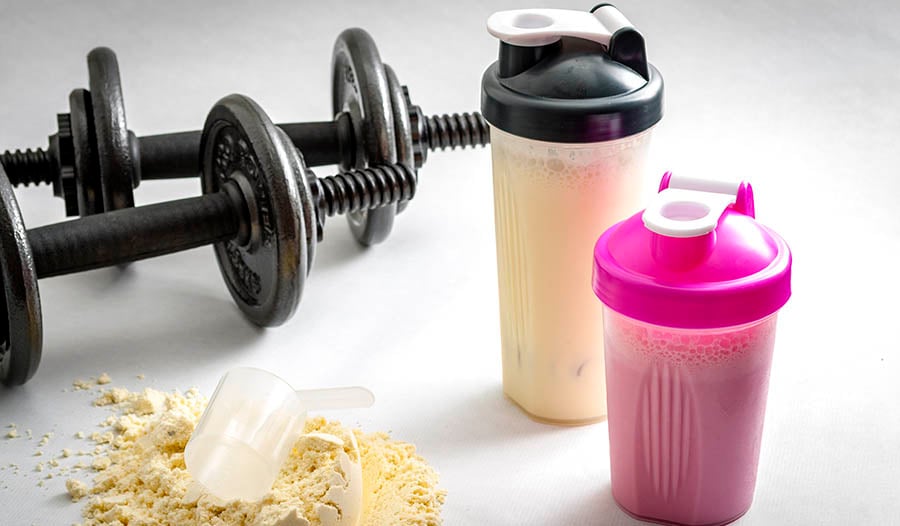Different Types of Protein Powders, from Whey to Plant-Based
DISCLAIMER:This blog does not intend to provide diagnosis...
- In this article:
- The Importance of Protein
- Protein Quality Matters
- How Much Protein Do You Need?
- Guidelines for Protein Powder Supplements
- Whey Protein Powder
- Casein and other Milk Protein Powders
- Egg White Protein Powder
- Collagen and Bone Broth Protein Powder
- Plant-Based Protein Powders
- How to Build a Nutrient-Rich Smoothie
- 3 Easy Smoothie Recipes

Originally posted August 2017 / Updated May 2023
The Importance of Protein
Market data shows that protein powder is the fastest-growing dietary supplement category. The reason is that more and more people are discovering the health benefits of boosting protein intake.
The word "protein" is derived from the Greek word proteios, or "primary." Not factoring in water, protein is the most plentiful component of our body. Protein functions as the structural scaffolding that holds our body together. It plays a major role in the structure of muscles, skin, hair, nails, tendons, ligaments, and other connective tissue structures. Proteins are also utilized as enzymes and hormones. Adequate protein is also critical in building muscle mass, controlling blood sugar levels, and supporting immune function.
Proteins are composed of individual building blocks of amino acids. The human body can manufacture most amino acids required to build proteins. However, there are nine "essential" amino acids that the body cannot manufacture. These have to be provided by diet or through supplementation. The quality of a dietary protein source is based on its level of these essential amino acids, digestibility, and ability to be utilized by the body.
Protein Quality Matters
In discussing protein quality, a few definitions are important to know.
Complete Proteins vs. Incomplete Proteins
A complete protein is a source that provides adequate amounts of all nine essential amino acids. Most animal sources, like meat, fish, dairy, poultry, etc., are examples of complete proteins. The exceptions are collagen peptides and bone broth proteins. Because they lack tryptophan, they are examples of incomplete protein sources.
Combining some incomplete protein sources can produce a complete protein if the sources complement each other with their amino acid profiles. The best-known example of this effect is combining grains, nuts, and seeds with legumes (beans).
Protein Digestibility Corrected Amino Acid Score
Nutritional science determines a protein's protein quality by determining its Protein Digestibility Corrected Amino Acid Score (PDCAAS). With the PDCAAS, a score of 1 is the highest, and a score of 0 the lowest.
While animal protein powder sources such as whey, milk, and egg have a PDCAAS of 1, the only plant-based protein powders that scores very close to a 1 is soy protein isolate at 0.98.
Other vegan proteins scoring high are pea protein concentrate 0.92, spirulina powder at 0.91, and pumpkin seed protein 0.9.
Protein powders from rice, sunflower seed, flax, chia, hemp, and sacha ichi generally to have values between 0.6 to 0.7.
While collagen peptides and bone broth protein have a PDCAAS score of zero because they have virtually no tryptophan, when these protein sources are incorporated into a typical diet, they produce an adjusted PDCAAS value of 1.2.
The same is true for plant-based protein powders. In other words, if a vegan diet is rich in a variety of types of plant-based protein sources (legumes, whole grains, nuts, and seeds), a deficiency of an essential amino acid is unlikely to occur.
It is recommended that vegans take advantage of plant-based protein powders to ensure adequate protein intake. Vegan protein powders also provide other beneficial compounds beyond protein, including dietary fiber, vitamins, minerals, and phytochemicals.
How Much Protein Do You Need?
Adequate protein intake is essential to good health. The Recommended Dietary Allowance (RDA) for protein is based on body weight (0.36 per lb or 0.8 g per kg of body weight). For a person weighing 68 kg (150 pounds), this amount comes to an RDA of about 55 grams of protein per day.
The RDA calculation is a good base for protein intake. However, there are many conditions in which extra protein (1.2 to 2.2 g per kg body weight) is needed, including those engaging in intense strength and endurance training during childhood/adolescence (growth), pregnancy or lactation, and in older populations.
A 1.2 g per kg bodyweight target is also a reasonable target for vegans, especially athletes or exceptionally physically active. Using plant-based (vegan) protein powder supplements to boost protein intake is an excellent recommendation to ensure adequate intake.
Guidelines for Protein Powder Supplements
- For general health support in those eating sufficient dietary protein and engaged in regular light exercise, target one 20 g serving daily.
- For those engaged in moderate levels of strength or endurance training, target 20 to 40 g daily.
- For those engaged in intense strength or endurance training and those desiring to build muscle mass a total protein intake of roughly 1.5 grams per kilogram of body weight is needed. Taking 20 to 40 g of protein powder twice daily.
There are many opinions about the best time to take a protein powder, but it makes the most sense to take protein powders for weight loss-promoting effects before a meal or as a meal replacement. If you take a protein powder to help recover from training or build muscle, then shortly after completing exercise makes sense.
One caveat—since the body does not need, store, or use excess protein, a high protein intake can stress the kidneys and liver. It can also lead to loss of calcium from the bone. So, it is essential not to overdo your protein intake.
Whey Protein Powder
Whey is the most popular protein powder supplement. Whey is a natural by-product of the cheese-making process. Cow's milk has about 6.25% protein. Of that protein, 80% is casein (another type of milk protein), and the remaining 20% is whey.
When cheese is made, it uses the casein molecules leaving whey. Whey protein is made by filtering off the other components of whey, such as lactose, fats, and minerals.
Whey protein is a complete protein in that it contains all essential and non-essential amino acids. One of the key reasons why the biological value of whey protein is so high is that it has the highest concentrations of glutamine and branched-chain amino acids (BCAAs) found in nature. Glutamine and branched-chain amino acids are critical to cellular health, muscle growth, and protein synthesis.
Whey comes in two primary forms: whey protein concentrate and whey isolate. Whey protein concentrates can vary in protein content from 25 to 89%. Whey protein concentrates generally contain a broader range of proteins and peptides. Whey protein isolates utilize filtration methods to concentrate the protein content to at least 90%.
Although the most popular use of whey protein is by bodybuilders and athletes looking to increase their protein intake, nearly everyone can benefit by adding whey protein to their diet.
Here are the main health benefits of whey protein:
- Whey protein has the highest biological value of any protein.
- Whey protein is a rich source of glutamine, the most abundant amino acid in the body.
- Whey protein is a rich source of branched-chain amino acids (BCAAs) that are metabolized directly into muscle tissue and are first used during exercise periods.
- Whey protein is a soluble, easy-to-digest protein and is efficiently absorbed into the body.
- Whey protein supplementation with resistance training improves muscle mass and muscular strength.
- Whey protein intake promotes satiety and improves blood sugar control.
- Whey protein contains bioactive components that help stimulate the release of three appetite-suppressing hormones, including glucagon-like peptide-1 (GLP-1).
- Whey protein is a valuable dietary tool for promoting weight loss.
In some parts of the world, high-quality whey protein powder is recognized as a functional food for preventing age-related muscle loss (sarcopenia) and maintaining blood sugar control and cardiovascular health.
Whey protein is a great option for making healthy, high-protein smoothies.
Casein and other Milk Protein Powders
Casein is a milk protein that accounts for 80% of the protein found in cow's milk. Like whey protein, casein is a high-quality complete protein. It is less popular than whey protein because it does not mix well in smoothies and is a little more expensive. Casein tends to be more allergenic than whey protein, but the two are very similar in promoting muscle recovery and response to exercise. Casein is metabolized and absorbed more slowly compared to whey. Therefore, promotes muscle repair and growth over a longer term.
Another protein from milk is milk protein isolate. It contains both casein and whey protein, produced from fresh milk via a low-heat, non-chemical filtration process used to preserve the chemical structure of the proteins. Milk protein isolates may contain lactose or be lactose-free. Milk protein isolates mix well in smoothies and other applications.
Egg White Protein Powder
Egg white protein powder is exactly what it sounds like: the dried, powdered form of the whites of chicken eggs. It is a complete protein offering some benefits over whey protein for some individuals. Egg white, or albumin, digests at a moderate rate different from fast-burning whey or slow-burning casein.
Meaning the benefits last longer than a whey protein smoothie. For those with a lactose allergy, egg white protein powder serves as a fully lactose-free protein powder. While whey, casein, or milk protein isolate may remove most lactose, trace amounts may remain.
Collagen and Bone Broth Protein Powder
Bone broth protein powder and collagen peptides are the fastest-growing protein choice in the marketplace. Bone broth protein powder is a collagen-rich protein source produced by making bone broth, concentrating it for the protein content, and dehydrating it to a powder. It can be derived from animal sources (chicken or beef) or fish. Bone broth protein powder is commonly used in savory recipes or consumed as a broth or soup base. However, it can also be used in smoothies.
Collagen peptides refer to collagen that has been partially digested for greater bioavailability and health benefits. Collagen peptides can also be from fish, chicken, or beef.
Supplementing with bone broth or collagen peptides is a great way to boost the building blocks for the body to assemble into its collagen structures. Collagen is the most abundant protein in the human body. The word collagen comes from the Greek word for glue. Collagen and hyaluronic acid (a sticky mucopolysaccharide) form the ground substance or "intracellular cement" that holds us together. It is also the major protein in the skin, hair, nails, joints, and gastrointestinal lining.
Clinical studies have shown considerable benefits from collagen peptide supplementation in improving the health of collagen-rich tissues such as joints, skin, hair, and nails. These studies usually provided a dosage of 5 grams a day.
Plant-Based Protein Powders
There are a variety of excellent plant-based protein powders on the market. For years the only choices were soy or rice protein powders. The market has expanded to other choices, including increased demand and the relatively cheaper cost of plant-based protein powders than animal protein powders.
Plant-based proteins show some of the same benefits in supporting muscle health and recovery after exercise and improving overall wellness.
In many cases, vegan protein powders are often blended to offer a more complete plant-based nutrition source.
Here are the top plant-based (vegan) protein powders listed based on popularity.
Pea Protein Powder
Pea protein powder has emerged as one of the fastest-growing protein supplements over the past twenty years and has probably replaced soy as the most popular plant-based protein. Pea protein is one of the complete plant-based proteins and has been shown in human clinical studies to promote muscle health, blood sugar control, appetite control, blood pressure support, and weight loss. Because pea protein lacks methionine but contains adequate lysine, it is often combined with other vegan protein powders (e.g., pumpkin, hemp, brown rice, etc.) to increase the essential amino acid profile.
Soy Protein Isolate
Soy protein isolate is a concentrated protein powder from soybeans. It usually has a 90% protein content and is a complete protein that contains all nine essential amino acids (see above).
Soy protein isolate has been studied intensely. These studies have shown to support cholesterol control and cardiovascular health, antioxidant mechanisms, and hormonal balance, especially during menopause.
Soy protein isolates often contain isoflavones. These flavonoids, often called phytoestrogens, can also help maintain bone health.
Spirulina Powder
For a good reason, spirulina is a blue-green algae highly regarded as a longtime favorite superfood for many health-minded individuals.
It has an excellent nutritional profile with a 60% high-quality protein content and many vitamins, minerals, and essential fatty acids. It also offers a rich source of valuable phytochemicals with antioxidants and supporting effects on immune system function and cardiovascular health.
Spirulina supplementation also helps protect skeletal muscle from damage during exercise and to help fight off fatigue.
Pumpkin Seed Protein Powder
Pumpkin seed protein powder is emerging as a popular "clean" protein source. It also tastes great unflavored, which many consumers prefer in a protein powder. Typically the protein content is 60% making pumpkin seed protein powder more of a whole-food protein source and a nutrient-rich food high in dietary fiber, vitamins, minerals, and phytochemicals.
While pumpkin seed protein powder is rich in most essential amino acids, like pea protein, it has relatively low amounts of methionine. Often pumpkin seeds are combined with other nut protein powders such as flaxseed, sunflower, and chia to preserve taste and the amino acid profile.
Brown Rice Protein Powder
Brown rice powder is another hypoallergenic protein often used in detoxification and allergy-elimination diet formulas. Because brown rice protein is not a complete protein and lacks sufficient lysine content, it is often combined with pea protein to make a complete protein.
Other Plant-Based Protein Powders
Less popular vegan alternatives are protein powders from defatted seeds and nuts such as chia, flaxseed, hemp, and sacha incha. Generally, these sources provide about 60% protein and have more of an earthy, nutty taste that many people prefer.
Though good protein sources, these other plant-based protein powders generally have lower levels of at least one essential amino acid, most often lysine. However, as stated above, if the diet is rich in various protein sources, including plant-based, the deficiency of an essential amino acid is unlikely to occur.
How to Build a Nutrient-Rich Smoothie
The most popular use of protein powders is in smoothies. It is an easy meal, snack, or just a nutritional boost. Place ingredients in a blender and liquefy. Here are some general guidelines.
Step 1: Choose Your Protein Powder
Depending on your needs and taste preference, choose a protein powder and add 20 to 30 grams.
Step 2: Choose your base liquid
A single serving, 16-ounce smoothie typically 12 to 16 ounces of a liquid base. Choose from:
- Plant-based milks such as almond, oat, or coconut milk.
- Milk or kefir
- Filtered water
- Tomato, celery, or carrot juice for savory smoothies
Step 3: Choose Your Featured Ingredients
Add 1 to 2 cups of featured ingredients. Here are some of the standard choices:
- Fresh or frozen berries
- Chopped apple,
- Raw coconut chunks
- Pineapple chunks
- Mango spears
- Chopped kale or spinach
- Savory choices:
- Bell peppers (raw red, green, yellow, orange)
- Beets (raw chopped)
- Celery (raw chopped)
Step 4: Nutritional boosts and spices
Smoothies are a perfect opportunity to add powerful phytochemicals to your diet. Here are some suggestions:
- Superfood Powders: 1 teaspoon to 1 tablespoon acai, raw cacao, goji, camu camu, or maqui powder
- Green Powders: 1 teaspoon to 1 tablespoon spirulina, chlorella powder, wheat grass, barley grass, or other green powder,
- Spices: 1 teaspoon fresh or ground ginger root, turmeric, curry powder, or cinnamon.
3 Easy Smoothie Recipes
Berry Smoothie
Mix the following in a blender and liquefy:
- 8-12 oz almond, oat, or rice milk, or soy milk (vanilla)
- 20 to 30 grams protein powder
- 1 cup frozen berries (blueberries, raspberreis, or strawberries)
Apple-Cinnamon Smoothie
Mix the following in a blender and liquefy:
- 8-12 oz almond, oat, or rice milk, or soy milk (vanilla)
- 20 to 30 grams protein powder
- 1 small red apple, chopped
- ¼ to ½ tsp cinnamon
Strawberry Banana Smoothie
Mix the following in a blender and liquefy:
- 8-12 oz. of cold water or vanilla soy milk
- 20 to 30 grams protein powder
- 1/2 cup fresh or frozen strawberries
- ½ cup sliced frozen banana
References:
- Grandview Research. Protein Supplements Market Size, Share & Trends Analysis Report. Report ID: GVR-1-68038-694-3.
- Paul C, Leser S, Oesser S. Significant Amounts of Functional Collagen Peptides Can Be Incorporated in the Diet While Maintaining Indispensable Amino Acid Balance. Nutrients. 2019 May 15;11(5):1079.
- Li M, Liu F. Effect of whey protein supplementation during resistance training sessions on body mass and muscular strength: a meta-analysis. Food Funct. 2019 May 22;10(5):2766-2773.
- Giglio BM, Lobo PCB, Pimentel GD. Effects of whey protein supplementation on adiposity, body weight, and glycemic parameters: A synthesis of evidence. Nutr Metab Cardiovasc Dis. 2023 Feb;33(2):258-274.
- Nouri M, Pourghassem Gargari B, Tajfar P, Tarighat-Esfanjani A. A systematic review of whey protein supplementation effects on human glycemic control: A mechanistic insight. Diabetes Metab Syndr. 2022 Jul;16(7):102540.
- Lesgards JF. Benefits of Whey Proteins on Type 2 Diabetes Mellitus Parameters and Prevention of Cardiovascular Diseases. Nutrients. 2023 Mar 6;15(5):1294.
- Huang LP, Condello G, Kuo CH. Effects of Milk Protein in Resistance Training-Induced Lean Mass Gains for Older Adults Aged ≥ 60 y: A Systematic Review and Meta-Analysis. Nutrients. 2021 Aug 17;13(8):2815.
- Bongers CCWG, Ten Haaf DSM, Catoire M, et al. Effectiveness of collagen supplementation on pain scores in healthy individuals with self-reported knee pain: a randomized controlled trial. Appl Physiol Nutr Metab. 2020 Jul;45(7):793-800.
- Evans M, Lewis ED, Zakaria N, Pelipyagina T, Guthrie N. A randomized, triple-blind, placebo-controlled, parallel study to evaluate the efficacy of a freshwater marine collagen on skin wrinkles and elasticity. J Cosmet Dermatol. 2021 Mar;20(3):825-834.
- Hexsel D, Zague V, Schunck M, Siega C, Camozzato FO, Oesser S. Oral supplementation with specific bioactive collagen peptides improves nail growth and reduces symptoms of brittle nails. J Cosmet Dermatol. 2017 Dec;16(4):520-526.
- Kerksick CM, Jagim A, Hagele A, Jäger R. Plant Proteins and Exercise: What Role Can Plant Proteins Have in Promoting Adaptations to Exercise? Nutrients. 2021 Jun 7;13(6):1962.
- Ahnen RT, Jonnalagadda SS, Slavin JL. Role of plant protein in nutrition, wellness, and health. Nutr Rev. 2019 Nov 1;77(11):735-747.
- Lonnie M, Laurie I, Myers M, et al. Exploring Health-Promoting Attributes of Plant Proteins as a Functional Ingredient for the Food Sector: A Systematic Review of Human Interventional Studies. Nutrients. 2020 Jul 30;12(8):2291.
- Xiao CW. Health effects of soy protein and isoflavones in humans. J Nutr. 2008 Jun;138(6):1244S-9S.
- Prokopidis K, Mazidi M, Sankaranarayanan R, et al. Effects of whey and soy protein supplementation on inflammatory cytokines in older adults: a systematic review and meta-analysis. Br J Nutr. 2023 Mar 14;129(5):759-770.
- Moradi M, Daneshzad E, Azadbakht L. The effects of isolated soy protein, isolated soy isoflavones and soy protein containing isoflavones on serum lipids in postmenopausal women: A systematic review and meta-analysis. Crit Rev Food Sci Nutr. 2020;60(20):3414-3428.
- Lafarga T, Fernández-Sevilla JM, González-López C, Acién-Fernández FG. Spirulina for the food and functional food industries. Food Res Int. 2020 Nov;137:109356.
- Lu HK, Hsieh CC, Hsu JJ, Yang YK, Chou HN. Preventive effects of Spirulina platensis on skeletal muscle damage under exercise-induced oxidative stress. Eur J Appl Physiol. 2006 Sep;98(2):220-6.

 By Dr. Michael Murray, N.D.
By Dr. Michael Murray, N.D. 


